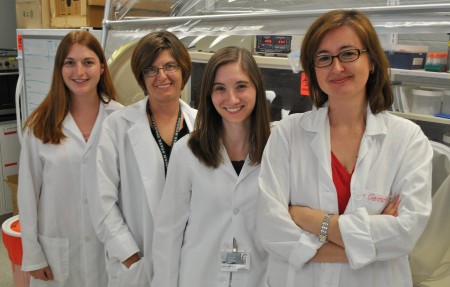Jul
11
A New and Huge Biofuel Production Process
July 11, 2012 | Leave a Comment
The team’s results have been published in the current issue of Environmental Science and Technology. The paper including co-author Allison Spears, a MSU graduate student, showcases a novel way to use microbes to produce biofuel and hydrogen, while consuming agricultural wastes. (This link will downland the paper from MSU.)
MSU microbiologist Gemma Reguera an AgBioResearch scientist has developed bioelectrochemical systems known as microbial electrolysis cells, or MECs using bacteria to breakdown and ferment agricultural waste into ethanol.
Reguera’s platform is unique because it employs a second bacterium, which, when added to the mix, removes all the waste fermentation byproducts or nonethanol materials and generates electricity.
Similar microbial fuel cells have been subjects for investigation before. But the maximum energy recoveries from corn stover, the common feedstock in the U.S. for biofuels, stalls at around 3.5 percent. Reguera’s platform, despite the energy invested in chemical pretreatment of the corn stover, averaged 35 to 40 percent energy recovery just from the fermentation process, said Reguera.
Reguera explains the huge productivity increase with, “This is because the fermentative bacterium was carefully selected to degrade and ferment agricultural wastes into ethanol efficiently and to produce byproducts that could be metabolized by the electricity-producing bacterium. By removing the waste products of fermentation, the growth and metabolism of the fermentative bacterium also was stimulated. Basically, each step we take is custom-designed to be optimal.”
The second bacterium, Geobacter sulfurreducens, generates electricity. The electricity, however, isn’t harvested as an output. It’s used to generate hydrogen in the MEC to increase the energy recovery process even more. Reguera said, “When the MEC generates hydrogen, it actually doubles the energy recoveries,” she said. “We increased energy recovery to 73 percent. So the potential is definitely there to make this platform attractive for processing agricultural wastes.”
Reguera’s microorganism fuel cells use corn stover treated by the ammonia fiber expansion process, an advanced pretreatment technology pioneered at MSU. AFEX is an already proven method that was developed by Bruce Dale, MSU professor of chemical engineering and materials science. Professor Dale is currently working to make AFEX viable on a commercial scale.
In much the same way Reguera is continuing to optimize her MECs so they, too, can be scaled up on a commercial basis. Her goal is to develop decentralized systems that can help process agricultural wastes.
Decentralized systems could be customized at small to medium scales (scales such as compost bins and small silages, for example) to provide an attractive method to recycle the wastes while generating fuel for farms.
These two women’s innovation and successful connection of two technologies is an astounding achievement. A 20-fold increase in product output has immense implications both in land use, costs and crop choices.
The other hand holds the matter of waiting for Professor Dale’s work and the transition to commercial scale. Both matters surely have solutions.
Yet the proverbial door has been opened. With those stunning productivity numbers every researcher in this field has an immediate rethink at hand. Commercial interests won’t be waiting for either the ladies or Dale. Things are sure to speed up.
Genius – take the sugars, co-process the ethanol remnants for hydrogen and use the hydrogen to produce more fuel. This is a very big breakthrough.


